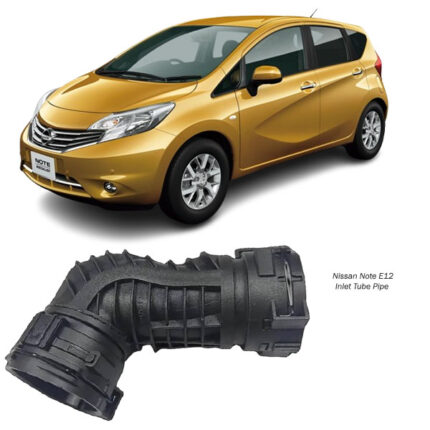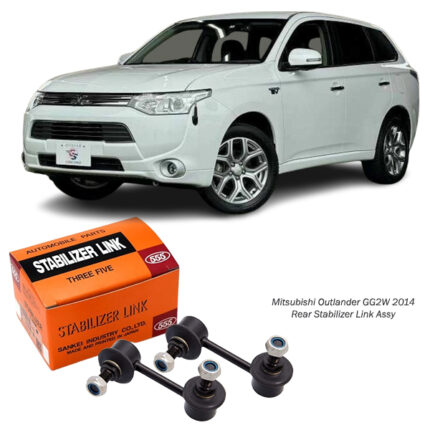-8%
Get Mitsubishi Outlander GG2W 2014 Rear Stabilizer Link Assy RH 0423-CW8RR in Kenya
The Rear Stabilizer Link Assembly (RH) is a crucial component in the suspension system of a vehicle, primarily designed to improve vehicle stability and handling. It plays a key role in ensuring the vehicle’s smooth ride by reducing body roll and enhancing the overall balance of the vehicle during cornering, braking, or other dynamic maneuvers. This guide explores the function, components, installation, maintenance, and common issues related to the rear stabilizer link assembly on the right-hand side (RH) of a vehicle.
1. What is the Rear Stabilizer Link Assembly (RH)?
The Rear Stabilizer Link Assembly (RH) is a part of the vehicle’s suspension system, specifically associated with the rear stabilizer bar (also known as the sway bar or anti-roll bar). The stabilizer link connects the rear suspension to the stabilizer bar, which in turn helps control body roll and keeps the vehicle stable when driving through turns or over uneven surfaces. The “RH” refers to the right-hand side of the vehicle, indicating that the part is designed for the right-side suspension.
This assembly is crucial for maintaining the vehicle’s stability, especially when driving at higher speeds, cornering sharply, or navigating bumps and dips in the road.
2. Components of the Rear Stabilizer Link Assembly (RH)
A typical rear stabilizer link assembly (RH) consists of several components, each with a specific role in its function. The main parts of the assembly include:
a. Stabilizer Link (or Sway Bar Link)
The stabilizer link itself is a metal rod that connects the suspension system to the stabilizer bar. It is designed to allow the suspension to move independently on each side of the vehicle while preventing excessive body roll. The link typically consists of a solid steel or aluminum rod, which is durable and resistant to the forces it faces during driving.
b. Ball Joints or Bushings
The stabilizer link is equipped with ball joints or rubber bushings at both ends to allow for rotational movement. These ball joints or bushings help absorb the forces generated during cornering and reduce friction in the system. Over time, these components may wear out, leading to noises or a loss of effectiveness in controlling body roll.
- Ball Joints: These are typically used in heavy-duty applications and provide a wider range of motion.
- Rubber Bushings: Rubber bushings are more common in light-duty vehicles and help dampen vibrations and reduce noise.
c. Bolts and Fasteners
Bolts and fasteners are used to securely attach the stabilizer link to the suspension components and stabilizer bar. These must be tightened to the manufacturer’s recommended torque specifications to ensure that the link remains securely in place during operation.
d. Stabilizer Bar (Sway Bar)
While the stabilizer bar is not part of the stabilizer link itself, it is a critical component of the system. The stabilizer bar runs across the vehicle’s suspension system, linking both sides of the axle. It helps reduce the amount of body roll during cornering by transferring forces from one side of the vehicle to the other.
3. Function and Role of the Rear Stabilizer Link Assembly (RH)
The primary role of the Rear Stabilizer Link Assembly (RH) is to connect the stabilizer bar to the rear suspension, helping to control the body roll during cornering. When a vehicle turns or encounters uneven surfaces, the body tends to lean to one side. The stabilizer bar works against this lean by distributing the forces to both sides of the vehicle.
Here’s how the rear stabilizer link assembly (RH) functions within the vehicle’s suspension system:
a. Reducing Body Roll
The most important function of the rear stabilizer link assembly is to reduce body roll. Body roll occurs when the vehicle leans to one side during a turn or when navigating rough terrain. This is particularly noticeable when cornering at high speeds. The stabilizer link transmits the forces from one side of the vehicle to the other, helping to balance the body and prevent excessive lean.
b. Improving Handling and Stability
By reducing body roll, the stabilizer link enhances vehicle handling. The vehicle remains more stable during turns, which contributes to safer and more responsive driving. This is especially beneficial in vehicles that carry heavy loads, as it helps prevent sway and improves traction on both the front and rear axles.
c. Enhancing Comfort
Though the primary purpose of the rear stabilizer link is to improve handling and stability, it also contributes to ride comfort. A well-functioning stabilizer link ensures that the vehicle’s suspension absorbs bumps and dips in the road effectively, resulting in a smoother ride. This is especially important for rear-wheel drive or all-wheel drive vehicles, where the rear suspension plays a significant role in overall vehicle comfort.
4. Installation and Replacement of Rear Stabilizer Link Assembly (RH)
Installing or replacing the rear stabilizer link assembly (RH) is a relatively straightforward process, although it does require basic mechanical knowledge. Here’s an overview of the steps involved:
a. Safety Precautions
Before starting, ensure the vehicle is safely elevated using a hydraulic jack and supported with jack stands. This will prevent any accidents while working under the vehicle. Additionally, it is advisable to disconnect the vehicle’s battery if any electrical components may be affected.
b. Removing the Old Stabilizer Link
The first step is to remove the old stabilizer link. To do this, you will need to remove any bolts or fasteners that attach the stabilizer link to the suspension components and stabilizer bar. Depending on the vehicle, this may require the use of a socket wrench or impact wrench.
Once the bolts are removed, the stabilizer link can be detached. If the link is stuck, tapping it lightly with a rubber mallet may help loosen it.
c. Installing the New Stabilizer Link
To install the new rear stabilizer link assembly (RH), first, position it correctly in place. Attach the new link to the suspension components and stabilizer bar, securing it with the appropriate bolts and fasteners. Be sure to tighten all bolts to the manufacturer’s specified torque setting to ensure that the link is securely fastened.
d. Reassembly and Testing
Once the new link is installed, reassemble any other components that may have been removed or loosened during the process. Lower the vehicle, then test the suspension by gently pressing on the rear of the vehicle to ensure that the stabilizer link is functioning properly.
e. Road Test
After the installation, conduct a road test to ensure that the vehicle handles as expected. Listen for any unusual noises (such as squeaking or rattling), which may indicate that the stabilizer link or other suspension components are not installed correctly.
5. Common Signs of a Faulty Rear Stabilizer Link Assembly (RH)
A faulty rear stabilizer link can lead to a variety of handling issues and may impact overall vehicle safety. Some of the most common signs that the rear stabilizer link assembly (RH) needs attention include:
a. Excessive Body Roll
If you notice more body roll than usual when cornering, it could be a sign that the stabilizer link is worn or damaged. This can cause the vehicle to lean more than expected during turns, affecting both handling and safety.
b. Clunking or Rattling Noises
A worn or loose stabilizer link may produce clunking or rattling noises when driving over bumps, potholes, or during sharp turns. These noises typically originate from the rear suspension and indicate that the link is no longer functioning properly.
c. Poor Handling and Stability
If the vehicle feels unstable or difficult to control, especially when making turns, this could be due to a faulty rear stabilizer link. The vehicle may feel “loose” or less responsive in corners, indicating a problem with the suspension system.
d. Uneven Tire Wear
In some cases, a malfunctioning stabilizer link can lead to uneven tire wear, as it affects the alignment and balance of the rear suspension.
6. Maintaining the Rear Stabilizer Link Assembly (RH)
To ensure the longevity of the rear stabilizer link assembly (RH) and the vehicle’s overall suspension system, regular maintenance is essential. Some tips for maintaining the stabilizer link include:
- Inspection: Regularly inspect the stabilizer link for signs of wear, such as cracked or worn bushings, corrosion, or loose bolts.
- Lubrication: If the link has bushings, ensure they are lubricated properly to prevent squeaking and reduce friction.
- Avoid Overloading: Avoid carrying excessive loads in the vehicle, as this can put undue stress on the suspension components, including the stabilizer link.
Conclusion
The Rear Stabilizer Link Assembly (RH) is a vital component in maintaining the stability and handling of a vehicle. It helps reduce body roll, improves handling during turns, and contributes to overall ride comfort. Whether for routine maintenance or when replacing a faulty link, understanding the role and function of the stabilizer link assembly is essential for any vehicle owner or mechanic. By ensuring proper installation, maintenance, and timely replacement of the stabilizer link, you can ensure the safety, comfort, and performance of the vehicle for years to come.
Follow us on Facebook for more parts.




